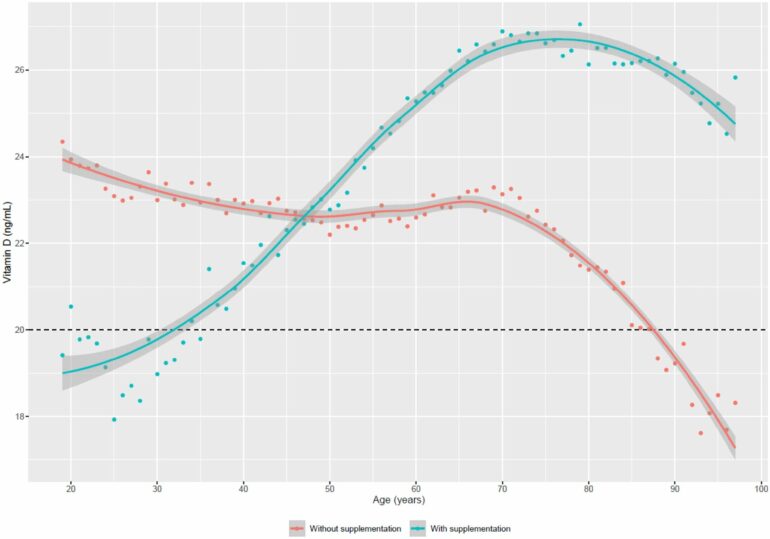Vitamin D is a hormone that is essential to a number of bodily processes, mainly absorbing and maintaining calcium, which is key for strong bones, but it also plays a role in inflammation processes, the immune system, cell growth and the metabolism. Given this, is it given sufficient importance?
The study “Paradoxical suboptimal vitamin D levels in a Mediterranean area: a population-based study,” led by member of the Universitat Oberta de Catalunya (UOC) Faculty of Health Sciences and the August Pi i Sunyer Biomedical Research Institute (IDIBAPS), researcher Diana Díaz Rizzolo, concludes that the population’s vitamin D levels are not sufficiently analyzed—a situation that is particularly serious for the population-at-risk—and questions the common practice of not providing the population with supplementation, despite the fact that levels remain low.
The study has been published in Scientific Reports.
The researchers analyzed a sample of more than half a million adults with big data techniques, with the support of the eHealth Center, using data from the PADRIS (Public Data Analysis for Health Research and Innovation) program, which makes anonymized data from the Catalan health system available to the scientific community. The individuals studied were aged over 18 and had been tested between 2018 and 2021.
Less than 10% of the population, analyzed for vitamin D
Díaz Rizzolo, who has Ph.D. in Biomedicine, explained that “the main way of obtaining vitamin D is to produce it yourself by exposure to sunlight. Paradoxically, in Mediterranean countries like Spain, the population’s vitamin D levels are lower than in northern European countries like Finland, UK, Iceland, Sweden and Ireland, which carry out vitamin D supplementation campaigns for their populations by systematic fortification of commonly consumed foods.”
“This, and other factors such as the use of sunscreen products and low consumption of vitamin D-rich food in Mediterranean countries, means that the population there has very low levels of vitamin D.”
To calculate vitamin D levels, the researchers based their work on the parameters established in the Endocrine Society’s Clinical Practice Guidelines, which set an optimum level of above 30 ng/ml, insufficient as from 20-30 ng/ml and deficient as below 20 ng/ml. The study shows that less than 10% of the population had been analyzed for vitamin D levels and that most of those that had were women aged 45 or over.
In fact, it is currently not recommended to analyze vitamin D levels in the population without symptoms, unless they belong to a risk group (the over-70s, pregnant women, the institutionalized and those with fractures or bone problems).
Of the population analyzed, 80% of young people had lower than desirable levels, but the majority were not given supplementation. However, vitamin D was prescribed to women over 45. This meant that, paradoxically, the oldest group had higher levels of vitamin D than the young.
For Dr. Díaz Rizzolo, “there’s a need to systematically measure vitamin D levels throughout the entire population over a specific period to provide a snapshot of what’s actually going on. And then, to carry out studies on how these levels impact people’s health, with a view to taking a simple decision: either supplementation is carried out when there’s a deficiency (through properly protocolizing groups or applying nutritional policies like our Northern European colleagues) or, if not, ceasing to carry out unnecessary measuring in populations that don’t need it, needlessly worrying them.”
Another of the study’s conclusions is that standards and recommendations for measuring vitamin D levels in at-risk groups are not complied with. Not only this, but when low levels are detected, supplements are not prescribed: “We need to review screening and action strategies for these groups, as the usefulness of vitamin D in the prevention of fractures and falls amongst the seniors, and with other problems associated with pregnancy and child development, has been clearly proven.”
Díaz Rizzolo asserted that a great deal more research into vitamin D is needed in order to be in a position to establish public health policies. What’s more, although there are no clear supplementation recommendations for those who, whilst not part of risk groups, have low levels, “many specialists prefer, in the case of doubt, to offer their patients supplementation. When weighing up the risks and benefits of supplementation, their preference is clear and they choose to do it.”
More information:
D. A. Díaz-Rizzolo et al, Paradoxical suboptimal vitamin D levels in a Mediterranean area: a population-based study, Scientific Reports (2022). DOI: 10.1038/s41598-022-23416-1
Provided by
Universitat Oberta de Catalunya (UOC)
Citation:
Vitamin D levels in the Spanish population are lower than those of many northern European countries, finds study (2022, December 14)


